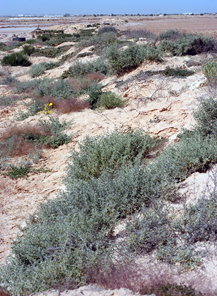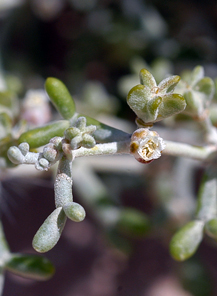Subgenus Stenosmia
Stenosmia Michener was formerly treated as a genus (Michener, 2007; Ungricht et al., 2008). However, in a recent molecular phylogeny of the osmiine bees (Praz et al., 2008b), Stenosmia was found to branch off from within the genus Hoplitis. Therefore, Stenosmia is treated here as a subgenus of Hoplitis. Stenosmia is confined to the Palaearctic region. It contains 15 described species.
Habitat of Hoplitis (Stenosmia) minima (Schulthess, 1924) in southern Tunisia, where the females collected pollen exclusively on Zygophyllum album (right). Foto A. Müller.
Species accounts
Hoplitis (Stenosmia) aravensis (Zanden, 1992)
1992 Stenosmia aravensis Zanden, Linzer Biologische Beiträge, 24: 822. Type material: Holotype m, “4 km W of Hazewa, Arava” [Israel], RMNH (Leiden); paratypes mm, ff.
Distribution-Southwestern Asia: IL, IR, SYR.
Identification-Keys, Descriptions: Zanden (1992c: 824); Müller (2014b: 314-315). As revealed by a large sample of H. aravensis collected in southwestern Iran in spring 2014 by S. Falamarzi, variation in body length is larger than hitherto assumed (Müller, 2014b): body length of females is 4.5-7mm and that of males is 4-5.5mm. In addition, the small hair patch on sternum 6 typical for males of H. aravensis (Müller, 2014b) is very inconspicuous in some individuals.
Nesting biology: Unknown.
Flower preferences: Probably oligolectic on Tamarix (Tamaricaceae) (Falamarzi et al., 2017; Müller, 2014b).
Hoplitis (Stenosmia) brunnescens (Benoist, 1950)
1950 Osmia brunnescens Benoist, Bulletin de la Société des Sciences Naturelles du Maroc (Rabat), 30: 188. Type material: Holotype f, “Marrakech, Oued Tensift” [Morocco], MZLS (Lausanne).
Distribution-Northern Africa: MA.
Identification-Keys, Descriptions: Zanden (1985: 68). Misapplication: The assignment of Hoplitis brunnescens (Benoist, 1950) to the subgenus Hoplitis by Warncke (1992a) is erroneous. The investigation of the female holotype revealed that H. brunnescens belongs to the subgenus Stenosmia and that the type specimen is probably conspecific with H. tagmouta (Warncke, 1991). However, the type slightly differs from typical females of H. tagmouta by the longer vertex and the reddish colour of legs and terga 1-3 (partly also of terga 4 and 5), rendering a synonymization premature. Only further material including males will show whether H. brunnescens and H. tagmouta are conspecific or represent two distinct species.
Nesting biology: Unknown.
Flower preferences: Unknown.
Hoplitis (Stenosmia) crassipunctata Müller, 2014
2014 Hoplitis (Stenosmia) crassipunctata Müller, Zootaxa, 3765: 304. Type material: Holotype m, “Lake, 50km E Balkhash” [Kazakhstan], ETHZ (Zurich); paratypes mm, ff. Type species of Stenosmia Michener (Müller, 2014b).
Distribution-Northern Asia: KZ, TM, UZ, RC(NW)
Identification-Keys, Descriptions: No supplementary or more detailed morphological description known.
Nesting biology-Nesting site: In excavated burrows in sandy soil. Colonies consisting of 5-20 nests have been found in sandy desert areas on takyr soil. The nests consist of a main burrow that ramifies into two or three side burrows. The brood cells, which are built at the end or at the side of these burrows at a depth of 3.5-7cm, open directly into the burrrow. Nesting material: The cells are closed with soil. The walls of burrows and brood cells consist of compressed soil, they are not lined with foreign material. (Marikovskaya, 1968, as Osmia flavicornis)
Flower preferences: Probably oligolectic on Tamarix (Tamaricaceae) (Marikovskaya, 1968; Müller, 2014b). This assumption is supported by observations made in southeastern Kazakhstan in 2024, where numerous females and males of H. crassipunctata visited Tamarix flowers (C. Schmid-Egger & W.H. Liebig, personal communication).
minima species group
Hoplitis (Stenosmia) albatera (Warncke, 1991)
1991 Osmia (Stenosmia) albatera Warncke, Entomofauna (Ansfelden), 12: 405. Type material: Holotype f, “Albatera/südwestlich Alicante” [Spain], OLML (Linz).-Combination Stenosmia albatera (Warncke) in Ungricht et al. (2008: 207).
Distribution-Europe: E.
Identification-Keys, Descriptions: Müller (2014b: 313); Álvarez Fidalgo & Pascual Hergueta (2024). Note: Male unknown.
Nesting biology: Unknown.
Flower preferences: One female was observed collecting pollen on Frankenia (Frankenia) in southern Spain (I. Cross, personal communication).
Hoplitis (Stenosmia) halophila Cross, 2023
2023 Hoplitis (Stenosmia) halophila Cross, Entomologist’s Monthly Magazine, 159: 79. Type material: Holotype f, “Huelva, Ayamonte” [Spain], Museu Nacional de História Natural e da Ciência (Lisboa); paratypes mm, ff.
Distribution-Northern Africa: E, P.
Identification-Keys, Descriptions: Álvarez Fidalgo & Pascual Hergueta (2024).
Nesting biology-Nesting site: In excavated burrows in salt marshes in horizontal sandy-mud on the fringes of mats of low halophyte vegetation, which are prone to indundation (Cross, 2023).
Flower preferences: Oligolectic on Frankenia (Frankeniaceae), e.g. F. laevis (Cross, 2023).
Hoplitis (Stenosmia) hartliebi (Friese, 1899)
1899 Osmia hartliebi Friese, Entomologische Nachrichten (Berlin), 25: 333. Type material: Syntypes m(m), f(f), “Fayum”, “Helouan” [Egypt].-Combination Anthocopa (Anthocopa) hartliebi (Friese in Zanden (1988b: 118). Combination Osmia (Stenosmia) hartliebi Friese in Warncke (1991b: 405). Combination Stenosmia hartliebi (Friese) in Ungricht et al. (2008: 208).
Distribution-Northern Africa: ET, LAR, MA, TN.
Identification-Keys, Descriptions: Warncke (1991b); Müller (2014b: 314-315); Álvarez Fidalgo & Pascual Hergueta (2024).
Nesting biology: Unknown.
Flower preferences: Probably oligolectic on Frankenia (Frankeniaceae) (based on Müller (2014b) and on field observations in southern Morocco in April 2017, where females were observed to collect pollen on Frankenia laevis).
Hoplitis (Stenosmia) kotschisa (Warncke, 1991)
1991 Osmia (Stenosmia) kotschisa Warncke, Entomofauna (Ansfelden), 12: 404. Type material: Holotype m, “Sereflikochisar/Ankara” [Turkey], OLML (Linz); paratypes mm, ff.-Combination Stenosmia kotschisa (Warncke) in Ungricht et al. (2008: 208).
Distribution-Southwestern Asia: TR.
Identification-Keys, Descriptions: Müller (2014b: 314-315).
Nesting biology: Unknown.
Flower preferences: The only two pollen loads analyzed so far originating from individuals of the type series consisted of pollen of Frankenia. Flower record: Frankenia hirsuta (Warncke, 1991b).
Hoplitis (Stenosmia) minima (Schulthess, 1924)
1924 Osmia minima Schulthess, Bulletin de la Société d’Histoire Naturelle de l’Afrique du Nord, 15: 314. Type material: Lectotype m, by designation of Zanden (1986: 68), “Kairouan” [Tunisia], ETHZ (Zürich); paralectotype f.-Combination Hoplitis (Tridentosmia) minima (Schulthess) in Zanden (1987: 68). Combination Stenosmia minima (Schulthess) in Ungricht et al. (2008: 208).
1991 Osmia (Stenosmia) minutissima Warncke, Entomofauna (Ansfelden), 12: 404. NOMEN NOVUM with same type specimen for preoccupied Osmia minima Schulthess [not Apis florisomnis minima Christ, 1791].
Distribution-Northern Africa: MA, TN. Southwestern Asia: IL, OM, UAE.
Identification-Keys, Descriptions: Warncke (1991b); Zanden (1986: 68); Müller (2014b: 313-315); Álvarez Fidalgo & Pascual Hergueta (2024).
Nesting biology: Unknown.
Flower preferences: Oligolectic on Zygophyllaceae; one pollen load consisted of pollen of Brassicaceae, suggesting that flowers of this plant family might occasionally be exploited as well (Müller, 2014b).
Hoplitis (Stenosmia) muelleri Álvarez Fidalgo, 2024
2024 Hoplitis (Stenosmia) muelleri Álvarez Fidalgo, Boletín de la Sociedad Entomológica Aragonesa, 75: 104. Type material: Holotype m, “Laguna de Peñahueca, Toledo” [Spain], MNCN (Madrid); paratypes mm, ff.
Distribution-Europe: E.
Identification-Keys, Descriptions: No supplementary or more detailed morphological description known.
Nesting biology: Unknown.
Flower preferences: Probably oligolectic on Frankenia (Frankeniaceae), e.g. F. thymifolia (Álvarez Fidalgo & Pascual Hergueta, 2024).
Hoplitis (Stenosmia) tagmouta (Warncke, 1991)
1991 Osmia (Stenosmia) tagmouta Warncke, Entomofauna (Ansfelden), 12: 405. Type material: Holotype m, “Tagmout N” [Morocco], OLML (Linz); paratypes mm, ff.-Combination Stenosmia tagmouta (Warncke) in Ungricht et al. (2008: 209).
Distribution-Northern Africa: MA.
Identification-Keys, Descriptions: Müller (2014b: 314-315); Álvarez Fidalgo & Pascual Hergueta (2024).
Nesting biology-Nesting site: In excavated burrows in sandy soil. An aggregation of about 20 nests was found on an area of roughly 3 square metres in southern Morocco near Sidi Ifni in April 2017. The nest entrances were all located on bare sandy soil between small shrubs of Frankenia laevis. Nesting material: Several females were observed to collect soil on the ground and to transport it over a distance of 10-15cm into their nests, suggesting that the walls of the brood cells and/or the walls of the nesting burrows are lined with soil. Interestingly, the females did not collect dry sand but instead harvested moister earth, which they found at the shaded base of Frankenia plants or in small soil crevices. (A. Müller, unpublished)
Flower preferences: Most probably oligolectic on Frankenia (Frankeniaceae) (based on Müller (2014b), on 11 pollen loads from 2 different localities, on the content of 3 brood cells and on field obervations). The males were observed to patrol both the flowers of Frankenia laevis and the nest entrances in their search for females; they regularly interrupted their patrolling flights by short resting periods on the ground (A. Müller, unpublished).
flavicornis species group
Hoplitis (Stenosmia) desertorum Müller, 2014
2014 Hoplitis (Stenosmia) desertorum Müller, Zootaxa, 3765: 308. Type material: Holotype m, “Fidan, 125km N Aqaba” [Jordan], ETHZ (Zurich); paratypes mm, ff.
Distribution-Southwestern Asia: IL, JOR.
Identification-Keys, Descriptions: Warncke (1991b, as Osmia flavicornis)
Nesting biology: Unknown.
Flower preferences: Possibly oligolectic on Reseda (Resedaceae); one pollen load also contained pollen of Echium (Boraginaceae), suggesting that Echium flowers might occasionally be exploited as well (Müller, 2014b).
Hoplitis (Stenosmia) dispersipunctata Müller, 2014
2014 Hoplitis (Stenosmia) dispersipunctata Müller, Zootaxa, 3765: 309. Type material: Holotype f, “Denev, 40km N Tzardjou” [Turkmenistan], ETHZ (Zurich); paratypes m, f.
Distribution-Northern Asia: KZ, TM, UZ.
Identification-Keys, Descriptions: No supplementary or more detailed morphological description known.
Nesting biology: Unknown.
Flower preferences: Unknown.
Hoplitis (Stenosmia) flavicornis (Morawitz, 1877)
1877 Osmia flavicornis Morawitz, Horae Societatis Entomologicae Rossicae (St. Petersburg), 14: 47. Type material: Lectotype m, by designation of Warncke (1991b: 406), “Etschmiadsin” [Armenia], ZIN (St. Petersburg).-Combination Osmia (Acanthosmia) flavicornis Morawitz in Schmiedeknecht (1885: 21 [887]). Combination Osmia (Stenosmia) flavicornis Morawitz in Warncke (1991b: 406). Combination Stenosmia flavicornis (Morawitz) in Ungricht et al. (2008: 208).
Distribution-Europe: ARM. Northern Asia: KZ, TM, UZ. Southwestern Asia: IR.
Identification-Keys, Descriptions: Ducke (1900); Mavromoustakis (1954b: 267); Schmiedeknecht (1885-1886); Warncke (1991b); Wu (2006); Zanden (1992c: 824); Müller (2014b: 314-315). Misapplication: Osmia flavicornis in the key of Warncke (1991b: 402-403) refers to Hoplitis (Stenosmia) desertorum Müller.
Nesting biology: Unknown. The observations on nesting and host plants reported by Marikovskaya (1968) for Osmia flavicornis most probably refer to Hoplitis (Stenosmia) crassicornis Müller.
Flower preferences: Possibly oligolectic on Peganum (Nitrariaceae) (Morawitz, 1877; Müller, 2014b).
Hoplitis (Stenosmia) gobiensis Müller, 2014
2014 Hoplitis (Stenosmia) gobiensis Müller, Zootaxa, 3765: 310. Type material: Holotype m, “Dornogov region, steppe, 28km SE Chatan-Bulag” [Mongolia], ETHZ (Zurich); paratypes mm, ff.
Distribution-Northern Asia: MGL.
Identification-Keys, Descriptions: No supplementary or more detailed morphological description known.
Nesting biology: Unknown.
Flower preferences: Probably oligolectic on Peganum (Nitrariaceae) (Müller, 2014b).
Hoplitis (Stenosmia) jordanica (Warncke, 1991)
1991 Osmia (Stenosmia) jordanica Warncke, Entomofauna (Ansfelden), 12: 406. Type material: Holotype m, “Fidan/125 km N Aqaba” [Jordan], OLML (Linz); paratypes mm, f.-Combination Stenosmia jordanica (Warncke) in Ungricht et al. (2008: 208).
1992 Stenosmia denticulata Zanden, Linzer Biologische Beiträge, 24: 823. Type material: Holotype m, “5 km NW of Irovat, Negev” [Israel], RMNH (Leiden); paratypes mm, f.- Synonymy in Müller (2014b).
Distribution-Northern Africa: ET, MA, TN. Southwestern Asia: IL, JOR, OM, UAE.
Identification-Keys, Descriptions: Müller (2014b: 313-315).
Nesting biology-Nesting site: In excavated burrows in sandy soil. A single nest was found in southern Morocco near Sidi Ifni in April 2017; its entrance was located on bare sandy soil. Nesting material: Unknown. (A. Müller, unpublished)
Flower preferences: Polylectic with a strong preference for Brassicaceae; other pollen sources include Reseda (Resedaceae) and Zygophyllaceae (Müller, 2014b). Flower records: Diplotaxis harra, Erucaria rostrata (label information).

